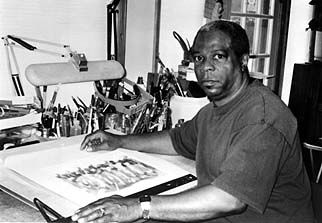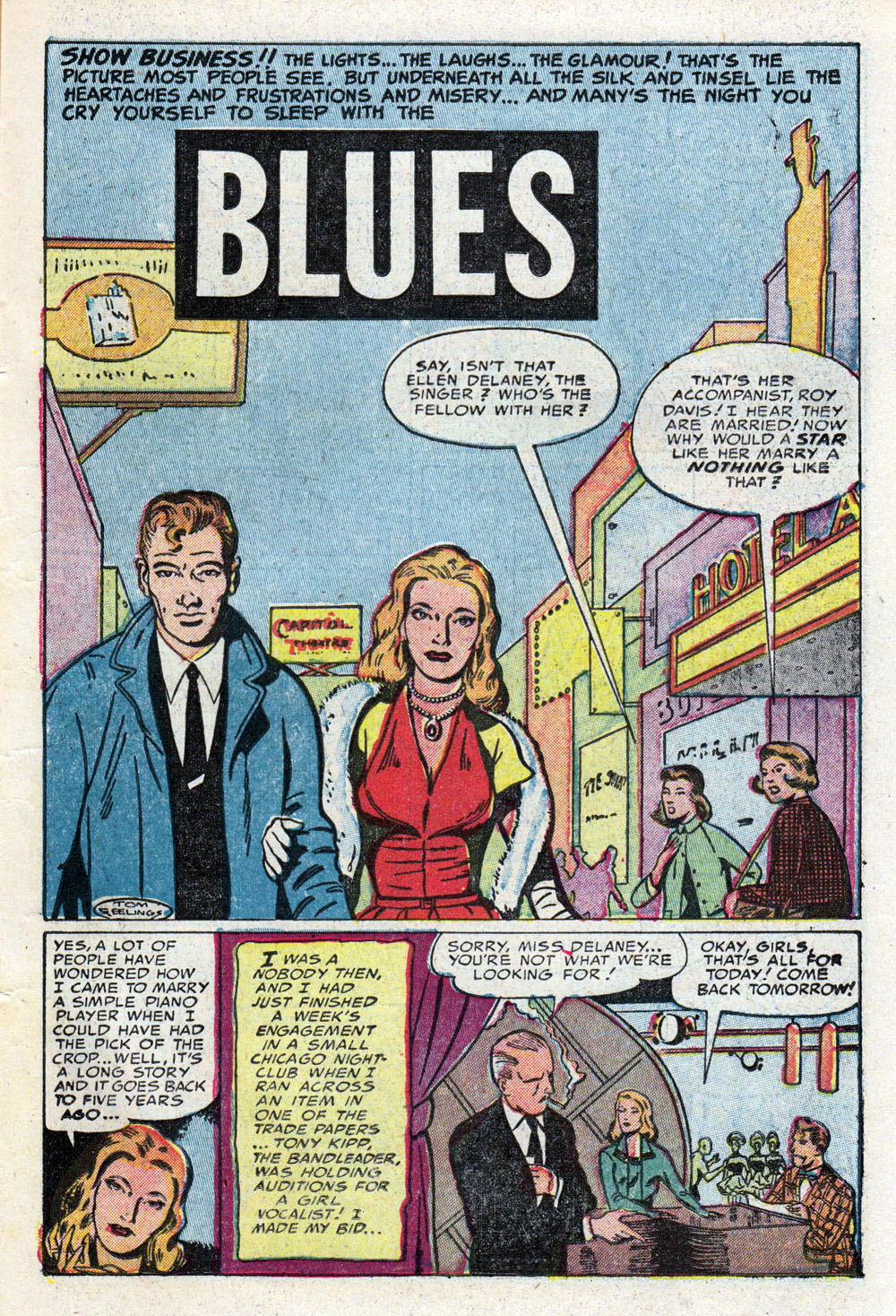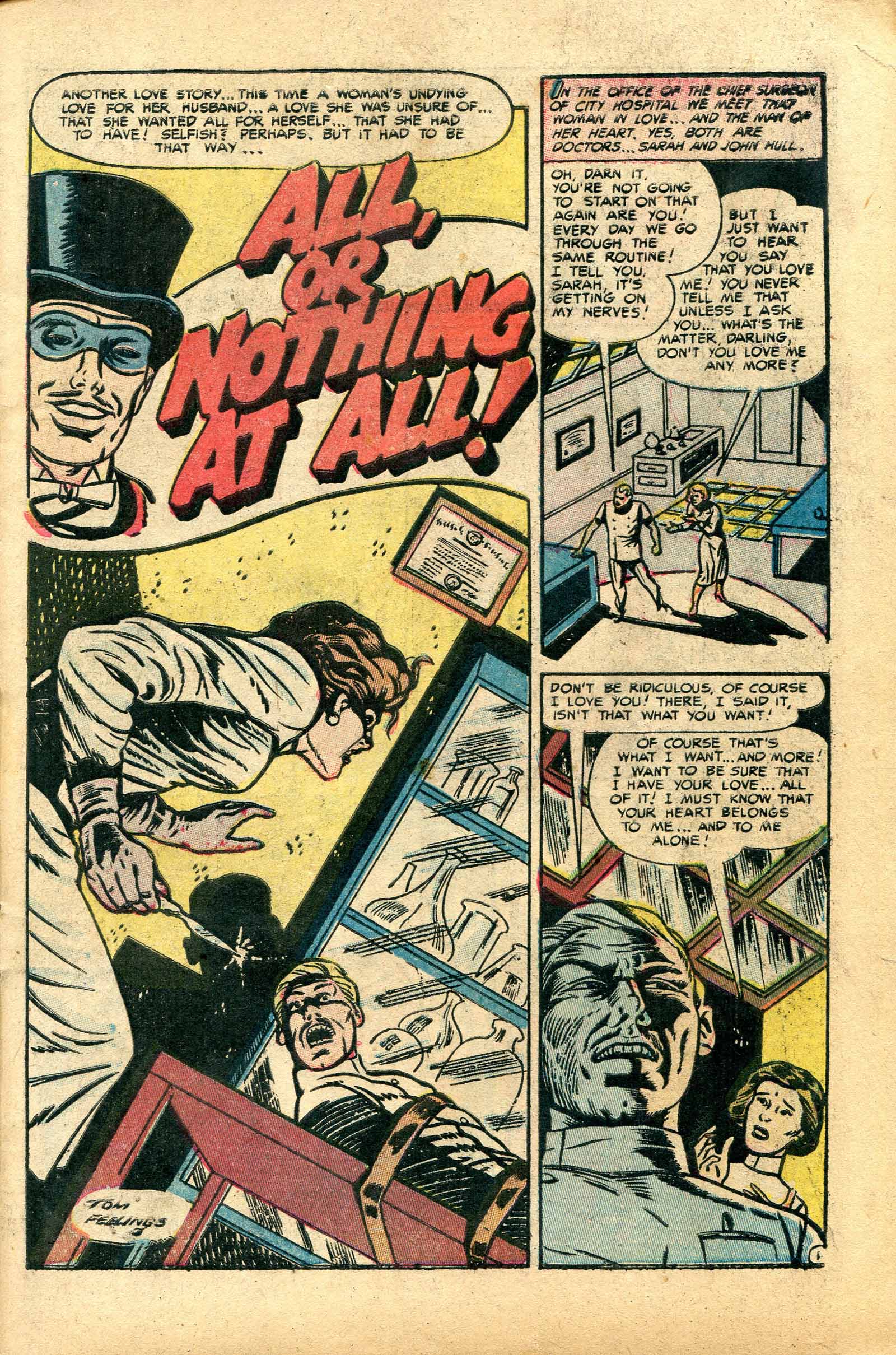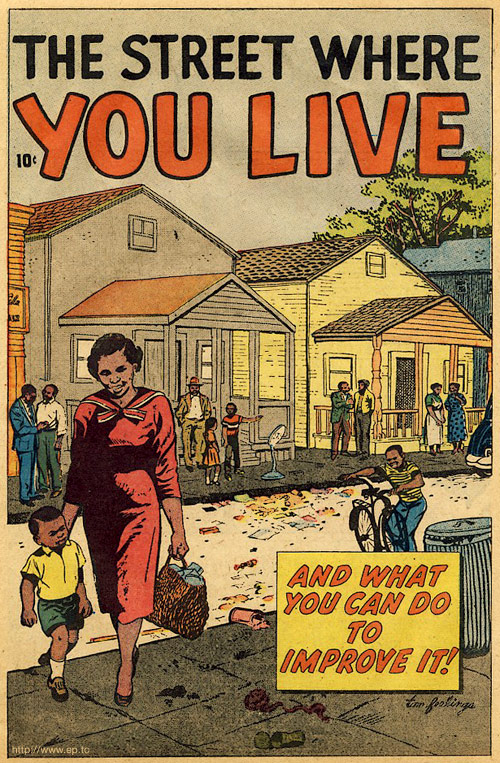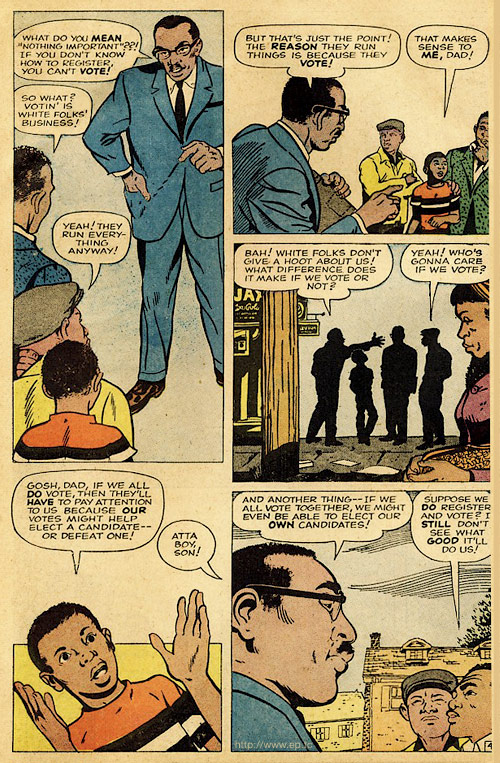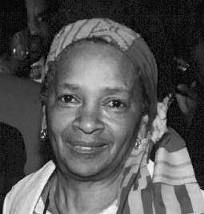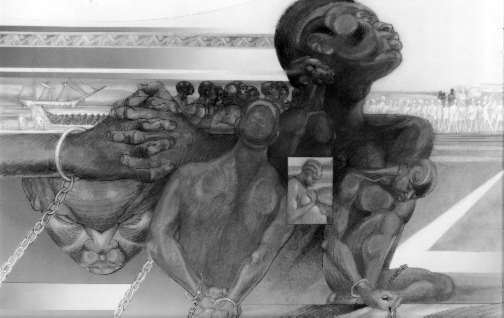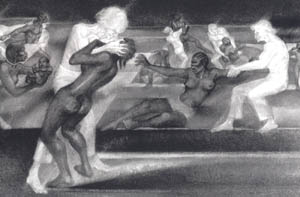Tom Feelings was born 19 May 1933 in the Bedford-Stuyvesant section of Brooklyn, New York. He was the son of Samuel (a cab driver) and Anna Nash (Morris) Feelings.
He drew from an early age and at four was copying comic strip images onto books sewn together by his mother. There was an artist teaching at the local Police Athletic Acadamy named Thipadeaux who took an interest in his work and encouraged him to draw from life, rather than copy others’ work. Thipadeaux was a serious teacher, encouraging Tom to constantly redraw and rethink what he was doing.
Tom was an avid student who welcomed the challenge and was also a strong reader who used the adult library at age nine to discover that Africans had made great contributions to society both here in America and across the globe.
After high school, Tom was given a three-year scholarship at Cartoonist and Illustrators’ School (now the School of Visual Arts)
He was apparently making the rounds of comic publishers during this time, and sold at least three pieces. His earliest known credit is Radiant Love 3, February 1953, and he also received signed credit in All True Romance 14, November 1953 and Mister Mystery 14, November – December 1953. The existing work shows a strong sense of comic books, polished by his studies at C&I.
Feelings however, joined the Air Force and served four years in England before returning to the US to continue his education. He returned to Cartoonists & Illustrators School, and graduated in 1961 with an extensive portfolio.
He had walked out of one class in art history when told by a professor that African art was considered ‘primitive’ and not ‘innovative’, and now he was being told by art directors that he would be more successful if he didn’t depict only African American subjects, but he had a vision of Afro-centric art that was rooted in his own life, culture and neighborhood. The lessons he’d learned as a child from Thipadeaux were still with him, and the world would catch up eventually.
He was clear about himself in a 1985 interview with Horn Book magazine. “I bring to my work a quality which is rooted in the culture of Africa and expanded by the experience of being black in America.”
In 1958 Tom wrote and drew the comic strip Tommy Traveler in the World of Black History for the New York Age, a Harlem paper, based on his own experiences at age nine discovering the true stories of black adventurers, cowboys and scientists at his library. The strips were collected in book form in 1991.
In 1960 Tom drew the comic The Street Where You Live, published by the National Association for the Advancement of Colored People. Considering his skill as a writer, there’s no reason to assume he didn’t write it, but no writing credit is given.
The Street Where You Live is a beautiful book. Sixteen full sized, full colored pages. The story involves a group of black citizens who organize to better their neighborhood, and who see positive changes and vow to continue to organize and vote regularly.
The story is full of natural dialogue, from the opening frustration of ‘If only we had a decent neighborhood to bring our kids up in, like they do on the other side of town’ to the closing promises of ‘We can get all our civil rights! We can break down Jim Crow! We can get better housing — better working conditions!’ , the story reads clearly and easily, and makes its educational points well.
The art is clear and well designed and the work of a mature pro. Mr Feelings’ art is strong and expressive, and his compositions realistic and full of detail.
Tom Feelings became known for more formal works, but to a comic fan, this is his masterpiece. This is where his politics, his love of children and community and his understanding of himself as an African American come together. This is real art. There is no artifice or commercialism here.
During the early 1960s he contributed to the magazines Freedomways and the Liberator, both of which had large black readerships and didn’t mind art that reflected their own lives.
By 1962 the editors at Look Magazine decided that maybe it wasn’t so odd that a black American artist would chose black American subjects, and Tom was sent to Louisiana where he stayed in a segregated Motel while he drew and painted the children of New Orleans.
In 1964 Kwame Nkrumah was the first president of Ghana. Born in Africa and educated in the United States, Nkrumah was an intellectual and a radical. Feelings traveled to Ghana at the invitation of the government. He worked on the official magazine, the African Review and illustrated children’s books. He was very aware of the importance of giving kids a beautiful image of themselves, and worked hard to do that. He felt connected and productive in Ghana, but Nkrumah was overthrown by a military coup in 1966 and Feelings returned to the United States.
By 1966 Tom’s Afro-centric sensibilities didn’t seem so unusual, and he illustrated the children’s book Bola and the Oba’s Drummers soon after arriving.
About this time he met Bertram A Fitzgerald, who was starting his Golden Legacy series of black history comics, and Tom worked with Joan Bacchus Maynard on the second issue, The Saga of Harriet Tubman. Ms. Maynard is widely recognized for her work in preserving the historic black community of Weeksville in Brooklyn. She wrote and illustrated the book, with Tom providing the inks.
Tom wrote the third issue and the art is credited to him and golden-age artist Ezra Jackson. Fitzgerald recalled that at that time Tom had already done a previous feature on Crispus Attucks, the first American casualty of the Revolutionary War, and it was adapted for the comic series. Crispus Attucks was also one of the subjects of the Tommy Traveler series.
His second book of illustrations was for Moja Means One; A Swahili Counting book, written by his wife , Muriel, who he married in 1968. The book was chosen in 1971 as a Caldecott Honor winner, a prestigious children’s book award. Tom and Muriel won a second Caldecott Honor in 1975 for Jambo Means Hello.
Tom was off to Guyana in 1971 to work for the Ministry of Education to produce children’s books and train artists. Despite antiquated two-color printing presses, he ‘learned to improvise in a restricted form’ before returning to the US in 1974. He and Muriel were divorced around this time.
Tom continued to work, and despite commercial success he always kept a certain kind of purity about his vision, once canceling a contract for a reprint of Booker T Washington’s Up From Slavery, because he couldn’t reconcile the realities of slavery with the sanitized optimism of the commercial art. But he was still meeting children that didn’t see a reflection of their own beauty in the culture at large, and didn’t recognize it in his work, and that made him more determined to keep that vision pure.
He continued working through the 70s and 80s and when The Middle Passage was published in 1995 he had illustrated at least a dozen books, and collaborated with such notables as Maya Angelou, the poet-laureate of the United States and Langston Hughes and won half a dozen major artistic and literary awards.
The Middle Passage is considered his masterpiece. It’s certainly one that comic fans can appreciate. The journey of people sold out of Africa and transported to the Caribbean and North America slave market is told in stark graphic detail, with no text. It’s a beautiful book and it won the Coretta Scott King Award for the illustrations in 1996.
Tom retired from the University of South Carolina, where he was an artist in residence, teaching book illustration. He died in 2001 of cancer in Mexico, where he was undergoing treatment. His obituary in the New York Times credited him with the illustrations to 20 books.
Muriel Feelings, his ex-wife and artistic collaborator died in Philadelphia 30 September 2011. Mrs Feelings was born Muriel Grey in Philadelphia, the daughter of Ada Erwin and Clifford Grey. She attended Philadelphia schools and then the Philadelphia Museum School of Art, later known as the University of the Arts.
She graduated from Los Angeles State College, now California State University, Los Angeles, earning a bachelor’s degree in art with minors in Spanish and education.
After graduation, Ms. Feelings taught at public schools in Philadelphia and New York.
Tom Feelings was an artist in a way that many artists are not. He understood himself as an artist and he believed that art has a function beyond decoration. He used his art as a tool for communication and social change, and he was dedicated toward social change. He said it clearly when talking about The Middle Passage to the Atlanta Chronicle ”I clearly did this book for black people so it would be something that inspires them. This book is also for whites who claim they can’t recognize what racism feels like.”
Tom was well known as an artist and writer, and obviously competent as a teacher and administrator. No mention of his comic work is made in any of the biographic pieces I found, yet he was an excellent cartoonist. His award winning The Middle Passage is indeed a beautiful book. Articulate without words, full of beautiful compositions and horrific detail. Once you know his work as a cartoonist, you can see that book as a continuation of the home-made books his mother sewed for him when he was a child.
I spoke to his ex-wife Muriel shortly before her death. She was sweet and courteous and spoke of Tom fondly with great admiration for his talent, but couldn’t tell me anything about his comic book work. It was a surprise to her. It was all done before she knew him, and he never considered the past as much as the future, she told me.
NOTES and REFERENCES:
Tom Feelings was obscure to me. I was aware of his Golden Legacy work, and happened to pick up Tommy Traveler, recognizing his name. When I got a copy of The Street Where you Live I noticed his name immediately and when I read the book I knew it was a classic, and when more people see it, it will be considered one. Looking at comic books on eBay one day, I saw Tom’s name again attached to an ad for Mister Mystery 14. Who is this guy, I asked myself…
Bertram Fitzgerald told me of his meeting Tom, who had already done previous African American comics work. It was he who first told me of Tom’s importance as an illustrator, and of Joan Bacchus Maynard’s works of historic preservation.
most of this article came from this source:
http://biography.jrank.org/pages/2346/Feelings-Tom.html
other minor facts were taken from Tom and Muriel Feelings’ obituaries.
Ethan Persoff has a copy of The Street Where You Live on his excellent site:
http://www.ep.tc/problems/34/17.html
The Digital Comic Museum has scans of the works listed above:

